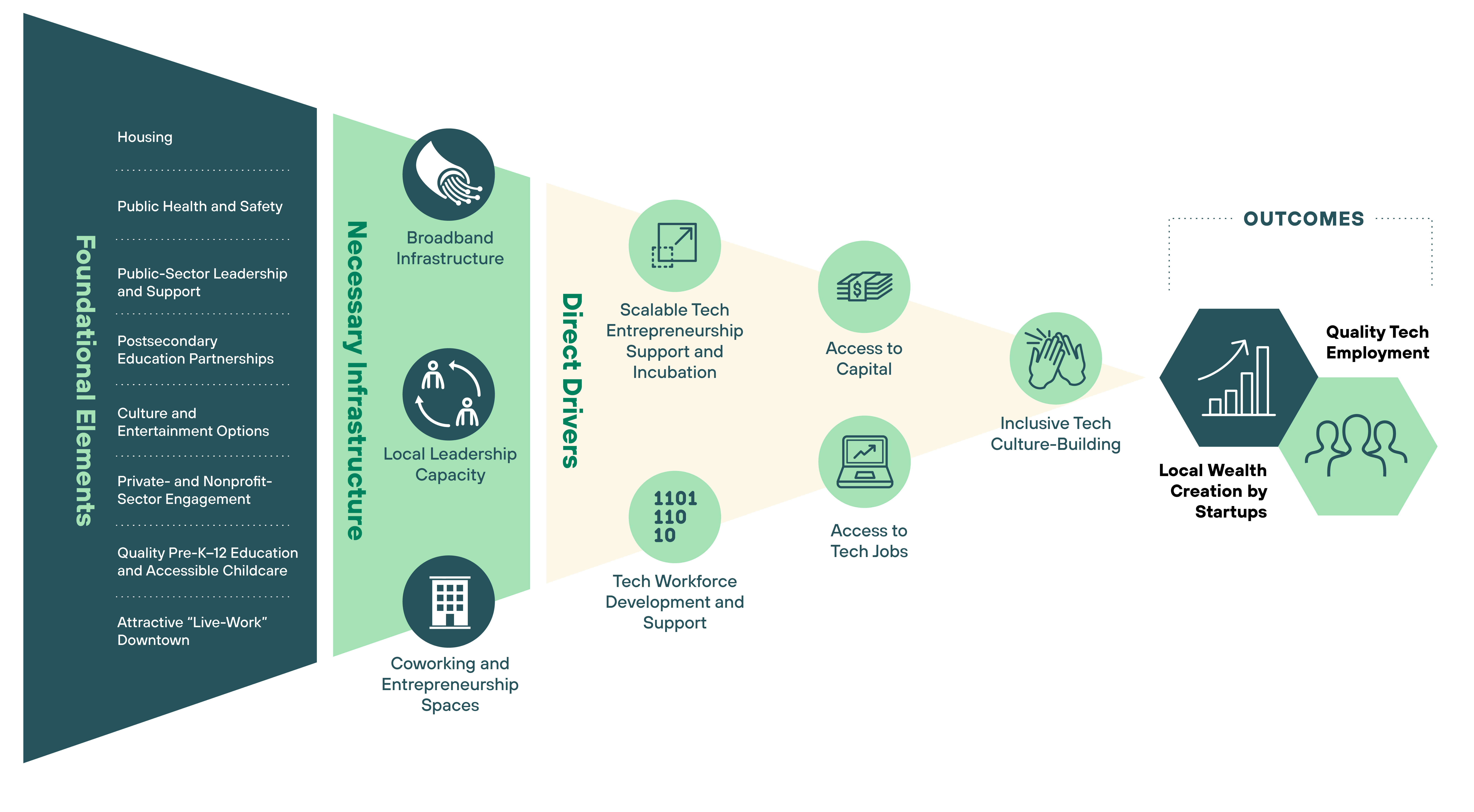Direct driver: Access to capital
Capital is at the core of a tech ecosystem: it’s what enables entrepreneurs to get their ideas off the ground and ultimately scale their products and services.
What are direct drivers of a tech economy?
How does a rural place build a thriving tech economy ecosystem? At the Center on Rural Innovation, answering that question — and helping communities put those answers into practice — is a core part of our mission.
Based on our deep experience in rural economies, on-the-ground work providing technical assistance on tech-based economic development with rural communities across the country, and intensive data analysis, we have identified five direct drivers of rural tech economy ecosystems — the elements that enable communities to successfully compete in the tech economy: scalable tech entrepreneur support and incubation; tech workforce development and support; access to capital; inclusive tech culture building; and access to tech jobs. As part of our work, we help rural communities — who each come to the table with different assets and strengths — develop strategies for implementing each of these drivers.
In this five-part blog series, we dive into each direct driver — defining it, explaining its purpose, highlighting rural communities in our Rural Innovation Network that exemplify doing it well, and offering tips on how other communities can drive their own success.
Direct driver No. 2: Access to capital
At the Center on Rural Innovation, we describe access to capital as a direct driver like this:
Scalable tech startups need to be connected with potential investors, either within or outside the community. Communities need to leverage and activate their networks as much as possible, and work with other communities to create mechanisms for local entrepreneurs to attract capital and vehicles for investors in the area to make investments.
Why capital matters
Capital is at the core of a tech ecosystem: It’s what enables entrepreneurs to get their ideas off the ground and ultimately scale their products and services. When capital is flowing into a community, the possibilities for new companies and jobs are exponentially greater.
That’s backed up by the data: A Brookings report found that venture capital-backed companies employ 11% of the private sector workforce, have growth rates 50% higher than the total private sector, see employment growth eight times higher than the average private company, and drive 21% of US GDP.
It’s important to note that for driving rural tech economy ecosystems, not all capital is created equal. Specifically, equity-based capital is the key to generating startup growth. A strong banking system and other forms of debt-based capital are still valuable for a local economy, but it’s venture capital investment that makes communities succeed on this digital driver.
With capital, rural communities can create regenerative wealth, where business growth benefits the local community and returns are leveraged to strengthen the local ecosystem and expand access to opportunity. This is especially possible when communities are able to raise capital locally; that way, when a company takes off or has an exit, it generates a major windfall for these local investors who are then able to use this new capital for further investment in the community.
Success stories from the Rural Innovation Network
- Durango, Colorado: The Southwest Colorado Accelerator Program for Entrepreneurs is a highly innovative model of regenerative rural venture capital. SCAPE was initially formed as an angel fund for local entrepreneurs by a group of local business owners, economic development groups, and angel investors. It grew to become a full-fledged six-month accelerator program, illustrating the important nexus between capital and entrepreneurship support.Today, SCAPE runs a private investment fund — powered mostly by local investors — that invests directly in successful SCAPE startups. SCAPE is explicitly focused on targeted economic development (and is supported by the Region 9 Economic Development District), and because it has been able to recruit local investors into the fund, it ensures that when SCAPE companies do well, the returns come back to the community. So far, those returns have been impressive: In seven years, SCAPE has helped rural companies raise over 24 million to create more than 150 jobs at above average wages.
- Red Wing, Minnesota: In 2017, a group of investors formed the Golden Triangle Fund, an angel group established to provide funding to early-stage, high-growth companies in Red Wing and southeast Minnesota. The fund is explicit about its goal to help the local economy through high-paying jobs, and is highly connected with the local ecosystem and assets, including the incubator at Red Wing Ignite.
- Springfield, Vermont: The Black River Innovation Campus is piloting a powerful model of using capital to support entrepreneurship. Through the Actuator — the organization’s new accelerator — the Brick by BRIC Fund (B3) provides seed grants to entrepreneurs in the program, with the potential for follow-on capital for successful participants. This structure de-risks startup entry while connecting founders with the resources needed to scale.
Strategy tips
- Create a local angel fund with investors from your community who care about your community. This will make you more likely to drive regenerative wealth and keep investors committed to your ecosystem.
- Integrate capital access with a strong entrepreneurship program. Startups and capital go hand in hand, and the better your pipeline of entrepreneurs, the better chance you have of raising the capital needed to scale up companies in your ecosystem.
- Ask investors for more than just capital. Often, local investors care deeply about the startups they’re supporting, and they also have deep experience in business themselves. By pairing investors as mentors with entrepreneurs, you can help companies succeed while showing investors the full return on their involvement.
Conclusion
For scalable entrepreneurship to take off, access to venture capital is the needed accelerant. While people too often think of venture investment as just something that can happen on the coasts, we’ve seen that communities in all places and of all sizes can make it happen. So long as they engage qualified local investors in their community and create space for entrepreneurs to launch investable startups, rural communities can attract venture capital and use it for sustainable, regenerative growth.
Keep reading
Interested in learning about our other direct drivers? You can read about each of them here:
- Direct driver: Scalable entrepreneur support and incubation
- Direct driver: Inclusive tech culture building
- Direct driver: Tech workforce development
- Direct driver: Access to tech jobs
To meet the Rural Innovation Network communities doing ecosystem building in small towns across the country, you can find a list here.
If you are a community interested in working with us to grow or build your own digital economy ecosystem, please contact us.

